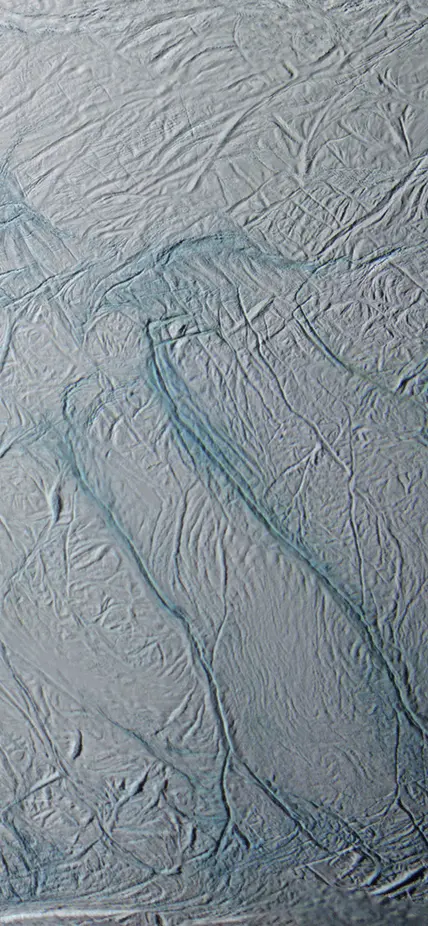A recent study, led by Doug Hemingway, a planetary scientist and Carnegie Postdoctoral Fellow, lays out in new clarity how Saturn’s icy moon, Enceladus, may have obtained its most iconic feature – the Tiger Stripes.
Since the Cassini spacecraft first brought the stripes to the world’s attention in 2005, planetary scientists have posited several explanations for their formation. Hemingway’s model is the first of these to simultaneously answer the following five key questions: (1) How do the fissures form? (2) Why do they form in a parallel set? (3) Why are they each around 35 kilometers apart? (4) Why do they appear on the south pole? And, (5) Why are they found only on Enceladus?
To answer these questions and understand why he chose to study the Tiger Stripes, we spoke with Hemingway.
Why Study the Stripes?
“Icy ocean worlds are arguably one of the most important classes of planetary body in the Solar System,” said Hemingway while discussing his research, “There’s a lot we still don’t understand about those bodies, so I’m trying to make sense of their interiors, characterize them, and discover how they come to be.”
When it comes to icy ocean worlds, Enceladus is particularly impressive. This frozen moon sports a unique geological feature: four or five (depending on how you count) parallel fissures in the south pole. These lines — dubbed the “Tiger Stripes”— are each around 130 kilometers long and are curiously spaced an even 35 kilometers apart.
These fissures in the ice connect the moon’s watery interior with its surface, creating pathways through which a mixture of water and complex organic molecules are sprayed into space. The smallest particles of this spray escape the gravity of Enceladus and compose the majority of an entire ring of Saturn. Larger particles fall back down to the moon’s surface as snow.
“So, this moon is sort of spraying its guts out into space,” explained Hemingway. “The best part is, you don’t even have to figure out how to land and drill through the ice to get access to the ocean. You can just scoop up the stuff that’s being sprayed out.”
The exciting molecular cocktail we can sample from this spray could provide the avenue to discover whether life exists beneath the moon’s icy surface.
“Understanding the link between the ocean and the surface is really important,” continued Hemingway, “and that means understanding the nature of these tiger stripe fractures.”
Explaining the First Stripe
According to prior research, Enceladus had to cool down before the Tiger Stripes could form. This cooling caused some of the moon’s water to turn to ice, thickening the ice shell, and increasing pressure on the moon’s liquid interior. Eventually, the pressure became too much for the shell to handle and it cracked.
Hemingway described the process, “The tension is going to build as the freezing progresses until there’s a failure somewhere in the ice shell.”
However, the location of the first crack would not have been random. Due to its elliptical orbit, Enceladus is repeatedly stretched and relaxed by Saturn’s gravity. This action, called tidal heating, warmed the moon at its poles, where it led to thinner ice.
“As a result, the first place that you’re going to get a failure is at one of the poles,” clarified Hemingway, “that’s the first fracture.” He continued, “I think it’s a coin toss whether the first failure happens at the south pole or the north pole, but once it happens, all of the subsequent activity then concentrates at that one pole.”
Follow the Leader
After the first fracture (a), the erupting snow begins to pile up and weigh down the moon’s icy shell (b). As the shell bends, new fractures form about 35 kilometers from the first. Those fractures start to erupt (c) and the cycle continues. Credit: Douglas Hemingway
With the first fissure formed, the pressurized ocean exploded through the crack in a massive eruption. The water crystallized into snow and began to fall back to the surface where it collected on the two edges of the fissure. Slowly but surely, the mass of material began to weigh down the now broken ice sheet, causing it to bend, and leading it to crack for a second time. According to Hemingway’s model, these new fissures would form in two parallel lines around 35 kilometers from the first, matching what we see on Enceladus.
Continuing to explain the process, Hemingway proposed, “Once this secondary fracture initiates, the stresses concentrate in an increasingly broken, and therefore thinner and weaker, elastic shell. The stress will actually increase at the crack tip, and you basically zip through the whole ice shell.”
At this point, Enceladus would have had three fractures, and the process of eruption and bending began anew, leading to fractures four and five.
“After that, you get far enough away from the south pole that the background ice shell is thicker,” revealed Hemingway, illustrating why there are not even more stripes on Enceladus, “and so we think it becomes harder for those secondary fractures to cut through.”
Only on Enceladus
Enceladus is not the only icy moon in our Solar System. So, why is Enceladus the only moon with stripes? Hemingway had a similar question, so he and his team tested their model under a variety of conditions. In his models, he found that increased gravity stopped the stripes from forming.
“Imagine a planet with the exact same ice thickness and the same elastic properties as Enceladus, but on a larger moon with more gravity, like Ganymede,” explained Hemingway. “The increased gravity would put so much pressure on the ice that it holds those secondary fractures shut.”
New Questions, New Answers, What’s Next?
Ice explosions, organic molecules, and Tiger Stripes aside, for Hemingway, identifying the unique nature of Enceladus was the most exciting part of the whole study.
“I think one of the coolest things is that we found an answer to a question that we weren’t looking for,” explained Hemingway. “We originally were just trying to explain the nature of why you get a series of parallel fractures and why they’re 35 kilometers apart. But the mechanism that we came up also turns out to only work for Enceladus.”
For scientists interested in studying the Tiger Stripes for themselves, Hemingway suggested, “think about ways that we didn’t think of to test the idea and either prove it wrong, confirm it, or maybe improve upon it. That would be the next best thing you can do.”

